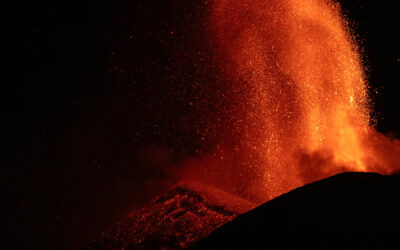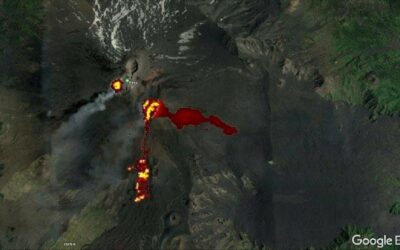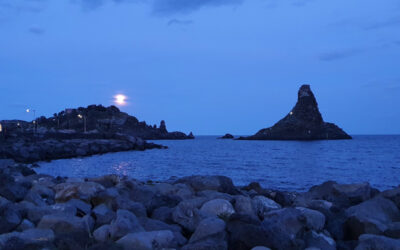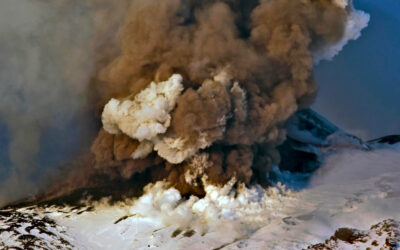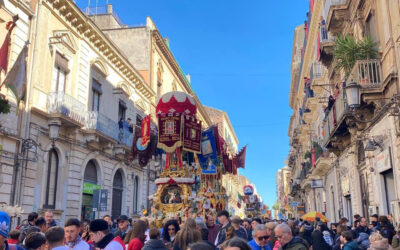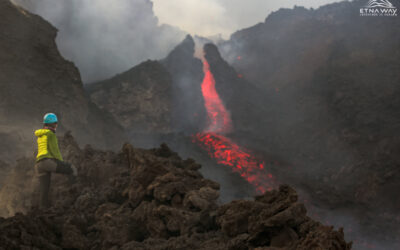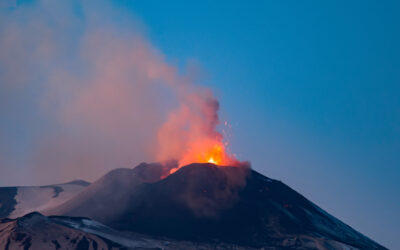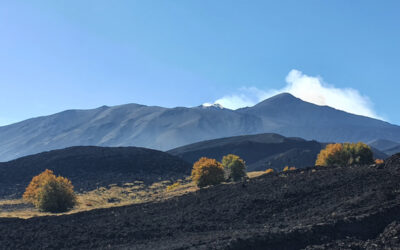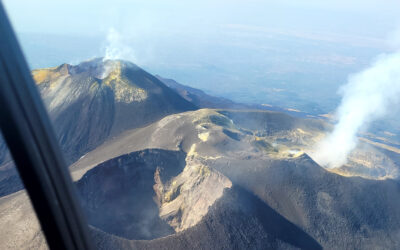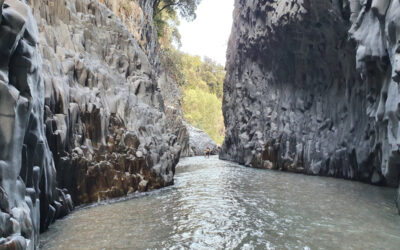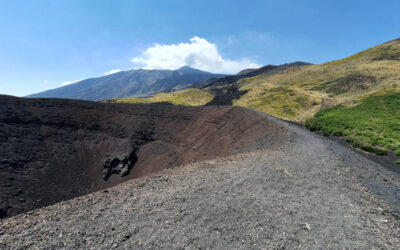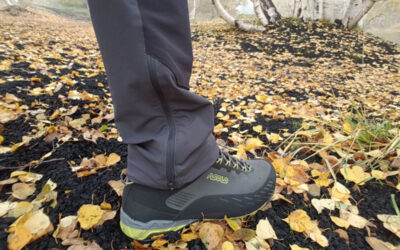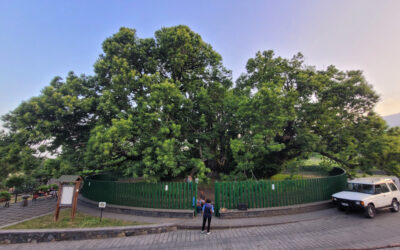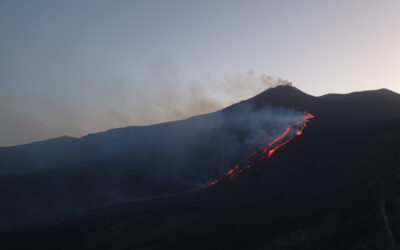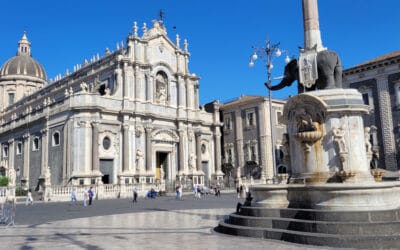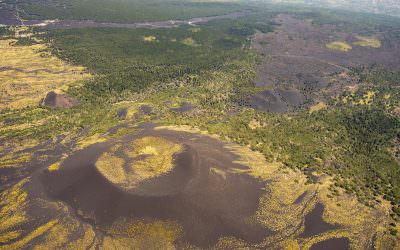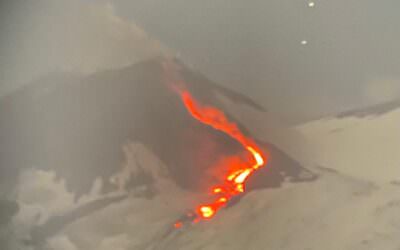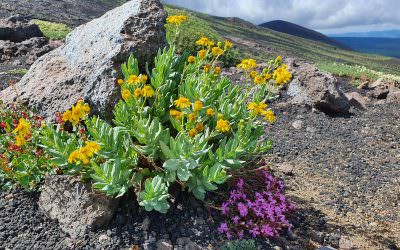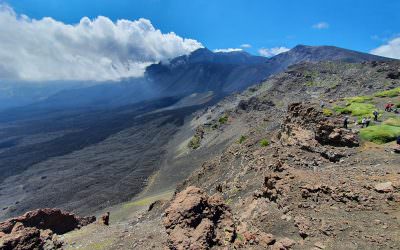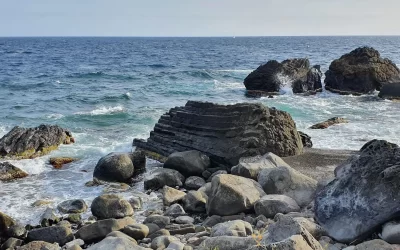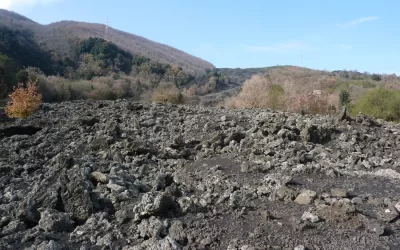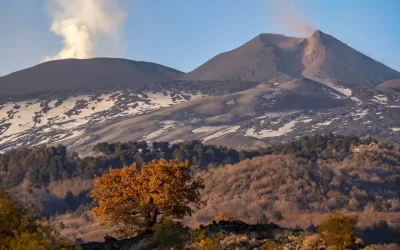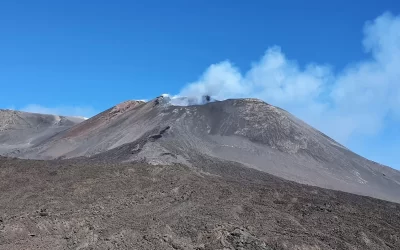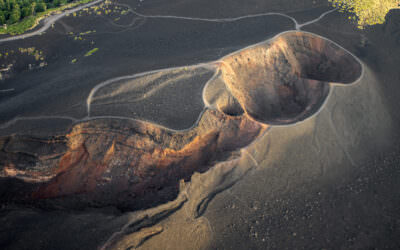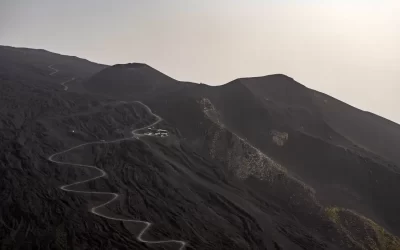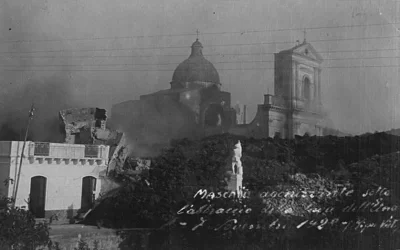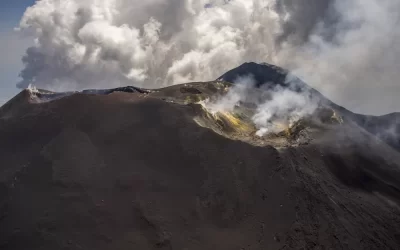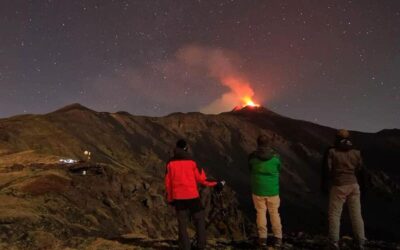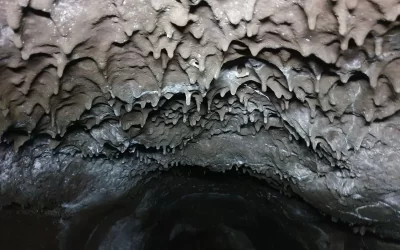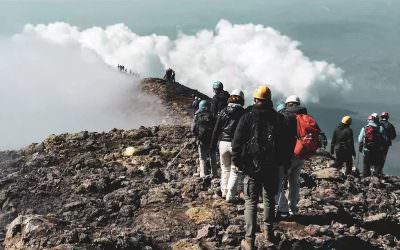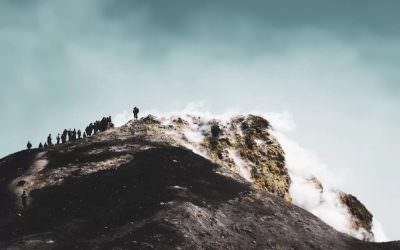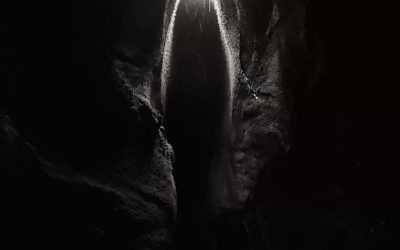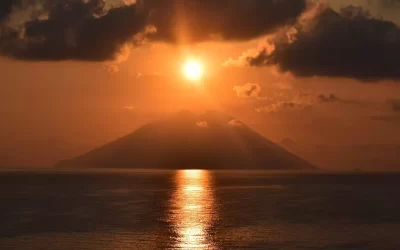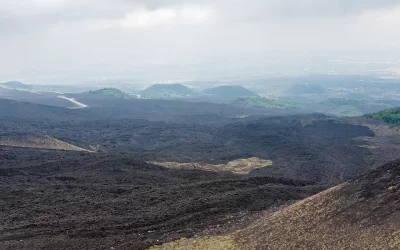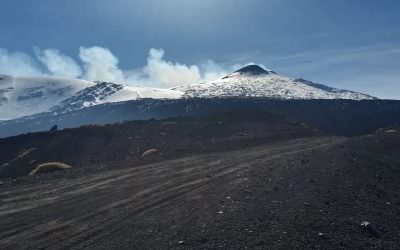Etna eruption 13.8.2023
On the afternoon of 13 August 2023, the measuring instruments of the Institute of Geophysics and Volcanology in Catania (INGV) register the first signs of a new eruption of Etna, which begins shortly afterwards - with Strombolian activity. Strombolian activity, typical of Stromboli volcano, is characterised by the emission of lava in the form of...
Mount Etna eruption 21.5.2023
After a series of earthquakes in the summit area and a sudden increase in volcanic tremor, Etna's awakening on 21 May 2023 was not long in coming. The protagonist of this eruption with lava fountains is once again the Southeast Crater. It has also produced two lava flows: one inside the Valle del Bove valley and a second, the main flow, along the...
Places to visit near Catania: Aci Trezza
Aci Trezza is located just under 10 kilometres north of Catania on the so-called Cyclops Coast. Once a small fishing village, it is now a popular holiday destination. The small town with about 5,000 inhabitants has a picturesque harbour, and directly off the coast are the Cyclops Islands, which are probably the main attraction. What to see in Aci...
Lava and snow: when extremes meet
The particularly low temperatures at the beginning of February 2023 and intense precipitation on 9 and 10 February 2023 transformed Etna into an idyllic winter landscape with snowdrifts that were four metres high in places and posed considerable challenges for some mountain huts. If you visit Etna in winter, especially its snowier northern side,...
Catania and the Sant’Agata Festival
Last weekend, from 3 to 5 February 2023, all of Catania was in a state of emergency: for three days, one of the biggest religious festivals in the world was celebrated. Millions of people flooded the streets in intense adoration of their city patron, Saint Agatha. The figure of St. Agatha is venerated in various forms throughout the year, but on...
Accidents on Mount Etna
In view of the occasion, here is another article today on the subject of "how dangerous is Etna? - this time, however, not primarily with reference to volcanic eruptions, falling rocks, lava flows and sulphur mist. It is about solo attempts, misguided adventurers, tragic-mysterious deaths. A night in ice and snow Just a week ago, on 9.12.2022, a...
How dangerous is Etna?
It is a mighty phenomenon; at around 3347 metres, it is considered the highest and most active volcano in Europe. It is constantly active, with eruptions almost every year. And yet it is densely populated: Catania with its more than 300,000 inhabitants lies at its feet, and countless villages stretch up its slopes. Thousands of visitors flock to...
Mount Etna in autumn
Mount Etna is worth a visit at any time of the year and offers a different sight every season. Especially the north side, where the barren, black lunar landscape alternates with forests, bushes and flowers, offers an ever-changing play of colours as the months change: In winter, the white trunks of the Etna birch (Betula aetnensis) barely stand...
Lucky charms and other symbols of Sicily
Today we would like to introduce you to some symbols that are often found in Sicily. They reflect the rich history of the island, but their meaning and origin are often not obvious at first glance. Testa di moro (Moorish heads) Whether as a flower pot or just for decoration, in Sicily you often find two ceramic vessels in the shape of two heads:...
Helicopter flight over Etna
A personal report A sightseeing flight over a volcano, by helicopter over summit craters and lava flows. This has always been my dream and now I have fulfilled it for myself - and my family: a flight over Etna, the largest active volcano in Europe, with EtnaWay. Our tour starts early in the morning. Visibility is usually best at this time of day....
Geological formations of Mount Etna
In addition to the 4 mighty main craters and the almost 300 lateral craters, Etna also harbours a number of other volcanic formations. We have already told you about some of them... Lava tunnel A lava tunnel is formed during an eruption when a crust forms on the surface of the slowly flowing lava in flatter terrain. The lava can continue to flow...
Etna North – The 2002 Craters
A personal report Today we are doing the North Craters Tour with EtnaWay, a tour to the craters from 2002. Meeting point is at 9am in Piano Provenzana on the north side of Etna. Our guide from EtnaWay is already waiting for us at the car park. We meet the others from the group and get to know each other over breakfast. In typical Sicilian style,...
The right equipment on Etna
Many people, including visitors who come from the Alps and often go hiking, underestimate Etna and the weather conditions. Even though Etna is very far south, it can be very cold. Also, the weather often changes very quickly because Etna is a single free-standing mountain and is not within a mountain range. We would therefore like to give you...
The chestnuts of Mount Etna
On the eastern side of Etna (from the north-east to the south-east) there are - due to the special climate - large occurrences of sweet chestnuts (Castanea sativa). The chestnuts are edible, but are not grown or collected commercially, as most of them grow in the Etna Park and are therefore protected. In winter, people in Sicily also like to eat...
Experience Etna live – a personal report
Since 13.5.2022, the south-eastern crater has been active again. At the foot of the cone, on its northern side, a fissure has opened. A lava flow has been pouring into the Valle del Bove, the huge valley on the eastern side of Etna. This is a subterminal eruption, i.e. an eruption of a main crater, but not at the very top (terminal eruption), but...
Catania and the elephants
At first glance, Sicily and Catania have nothing to do with elephants. Yet a red elephant is emblazoned on Catania's coat of arms and in the heart of the city in Cathedral Square (in front of Sant'Agata Cathedral), a black elephant with an obelisk on its back stands in the middle of a fountain - Catania's emblem. What is this all about? The coat...
Where do the names of Etna’s craters come from?
Mount Etna has not only 4 main craters, but also almost 300 lateral craters. Every hill we see in the vast Etna area is an extinct lateral crater. Lateral eruptions are so-called monogenetic eruptions, i.e. openings that are active only once and then are so firmly closed that they never erupt again. The main craters, on the other hand, are...
Etna Current – 13.5.2022
The south-eastern crater does not come to rest: the currently highest and most active main crater of Etna provides spectacular images again on the evening of 13.5.2022. This time the activity does not start with strombolian activity. A lava flow is descending on the northern side of the Southeast Crater and has already reached the base of the...
Sicily – Culinary Diversity from North to West
A round trip for all the senses Sicily, the largest island in the Mediterranean Sea located in the southwest of Italy, is not only home to the highest active volcano in Europe, Mount Etna, but also has impressive cities to offer in addition to beautiful beaches. No matter which side of the island you are on, in each city you will find different...
The plant diversity of Etna
The Sicilian flora is characterized by many endemic species. They make up about 10% of the island's plant species. In this article we want to tell you about some of the special plants that grow on Etna. Because anyone who thinks Mount Etna is a barren, lifeless stone desert is wrong. Etna provides habitat for a variety of animals and plants and...
The Valle del Bove
The Valle del Bove (Valley of the Ox) is a huge valley about 5 km wide and about 7 km long (37 square kilometres in total) on the eastern side of Mount Etna, facing the sea. The rims of the valley are up to 1,000 metres high and some of them drop vertically. The formation of the Valle del Bove According to the latest research, this impressive...
The formation of Sicily
We already told you in an earlier article (Lava tubes of Etna I) how Mount Etna was formed. However, how did Sicily originate? Originally, there was sea on the site of what is now Sicily. Plate tectonics, or more precisely the fact that the African plate is sliding under the Eurasian plate (subduction), has caused the ground to rise. At first,...
The 1991 – 1993 eruption
The eruption that kept Zafferana in suspense! This time we report in more detail on the eruption between 1991 and 1993, which scared the inhabitants of Zafferana Etnea - a small town on the eastern side of the volcano. The beginning of the eruption On December 14, 1991, fractures opened both to the north and to the south of the Southeast Crater....
The flag of Sicily
The flag of the (autonomous) region of Sicily (one of the 20 regions of Italy) features a decorated woman's head on a red and yellow background. This flag, as we know it today, dates back to the 13th century. But the history of this symbol is much older. The colours of the background (red and yellow) stand for the cities of Palermo and Corleone...
Etna’s Summit Craters – Southeast Crater
Let us take a closer look at the scenario of the main protagonist of the last 50 years: the Southeast Crater. The birth of Southeast Crater in 1971 Let us start at the beginning: After a century of profound transformations and intense activity of the summit craters, on 5 April 1971, strong lateral activity gave way to a new phase characterised by...
Legends about Etna
Etna has always fascinated people – as the source of great ruin and great fertility. There are therefore many legends and myths surrounding this volcano, from which we would like to give you a small extract today. The forge of Hephaestus Hephaestus is the Greek god of fire and blacksmithing. The Romans later gave him the name Vulcan, from which...
Eruption of Etna October 2002 / January 2003
In this article, we tell you about the 2002 eruption, an extraordinary event in which two eruptive systems are active at the same time, one on the south side and one on the north side of Etna. A little more than a year has passed since the spectacular eruption of 2001 and on 26 October 2002, the spectacle begins again. During the evening, some...
The 2001 eruption of Etna
Two eruptions in one Today we tell you about the first eccentric outbreak that has been scientifically documented. In an eccentric eruption, the magma does not reach the top via the main vent, but seeks another path from the magma chamber to the surface. Since it has to break through hard lava rock from previous eruptions, such eruptions are very...
The 1928 eruption
Destruction and reconstruction of Mascali the last one that destroyed a town; the only recent lava flow that stopped a few hundred meters from the sea, at an altitude of 25 m above sea level; and one of the eruptive events that, together with that of 1669, had a stronger socio-economic impact in the history of Etna. The 1928 eruption is an...
The Central Crater of Mount Etna
The Central Crater, probably formed during the great eruption of 1669 on the ruins of another pre-existing cone, consists of a 500 m diameter mouth at the centre of a 250 m high cone. Looking at Etna from the sea or from the coast, from the foot of its eastern flank, one can clearly see that this cone is in fact only the last, the youngest peak...
A day on Etna
Fascinating impressions on the highest active volcano in Europe Between sea and snow – 1800 metres above sea level, far away from city traffic and beach promenade and yet so close. In the year 2020, the Etna became my refuge from all the media reports about the corona virus. Here, where the world is still in order, high up on the Sartorius...
Typical food in Eastern Sicily
Sicilian cuisine is the result of a mixture of different influences from the many cultures that inhabited the island over time. It's all in the mix What still characterises our dishes today is a heritage of culinary traditions from very different civilisations that have contributed to the creation of an absolutely rich gastronomy, an explosion of...
Lava tubes of Etna II
Or: Why the Catanese invented ice cream. If you follow our blog closely, you already know how lava tunnels are created during a volcanic eruption. This time we want to tell you something about what it looks like inside these caves and what special things have already happened in some caves. Geological peculiarities Let's start at the end of the...
The New Southeast Crater
The world's second most active volcano shows us its vehemence: in 2004, a new summit crater is formed which is already history by 2021. We could say that, just as the beginning of the activity in 1971 was characterised by a collapse on the eastern flank of the Central Crater, so the 2004 collapse on the eastern flank of the Southeast Crater...
Etna’s Summit Craters – North-East Crater
From 1 to 4 craters in only 100 years Mount Etna is the largest active volcano in Europe, with a volcanic surface of 1250 square kilometres and a diameter of 45 km from east to west and as much as 65 km from north to south. The volcano has a unique and distinctive shape, not only because it shows some signs of its evolutionary phases from...
Lava tubes of Etna I
Or: What Ulysses did on Mount Etna When visiting Etna you should not only take a hike to the countless craters and lava flows, but also go and see one of the approx. 190 lava tubes (these caves are scattered over the entire Etna so you can reach them easily on any tour). How lava tubes are formed These subterranean tunnels develop during an...
Aci Trezza and Aci Castello
Along the Sicilian east coast, at the foot of Europe's highest active volcano, lies the so-called Cyclops Coast. We are here just a few kilometres north of the city of Catania, which is also called the black daughter of Etna. It got this name after being surrounded by the eruption of 1669 and completely destroyed by the earthquake of 1693 and...
Stromboli volcano: Lava and Malvasia
In Sicily, there is not only the famous volcano Etna, but also the smaller Stromboli. Two wonderful active volcanoes, but with profound differences. Age: while Etna was born about 570.000 years ago, Stromboli is much younger, being only about 160.000 years. The heightof the two volcanoes also has a significant difference: while Etna dominates...
East Etna from Riposto to Valle del Bove
The eastern side of Etna is the richest in landscapes and climates, and since the SouthEast Crater (one of Etna's 4 summit craters) began its activity in 1971, it is also the side that changes the most. Riposto: the start of the Etna East Route We leave from the sea, from Riposto, a small town that owes its name to the storage of barrels. In the...
DOC wines of Etna
What's better than a good glass of Etna wine after a nice trekking? Each wine region offers its own unique places and special grape varieties. In Sicily, Etna with its 1000 faces invites you to hike, either high up on the summit craters in steep areas or through the gentle forests of Etna's pine, beech, chestnut or birch trees. On Etna, you can...
Round tour on the north side: from Serracozzo to the Sartorius craters
We visit a piece of paradise on the north-east side of Mount Etna. Besides craters, lava flows and grottos, we see countless fantastic formations created by our beloved Etna (if you want to experience the tour yourself, book our Etna North Tour). At 1740 m, at Rifugio Citelli, base no. 15 of the Parco dell'Etna, we enter a grove of beech, pine...
Etna Nord from Linguaglossa to Pizzi Deneri
Etna National Park, North side We start from the north area of the volcano along the man-made ring of the so called “wine road”.Linguaglossa is a small village situated in on the Etna Nord side. Well known for its production of Etna wines and typical Sicilian foods like hazelnut. From here we take the Mareneveprovincial road, the only access road...

